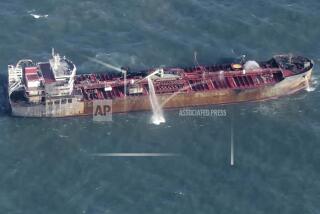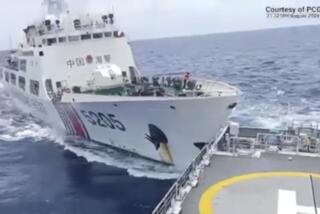Sea traffic at Great Barrier Reef seen as a menace
- Share via
Reporting from Sydney, Australia, and Seoul — Over the years, retired Australian fishing captain Mike Prior has seen their numbers grow, the large trawlers and freighters cruising recklessly through federally protected waters without proper guidance.
On Tuesday, authorities were investigating the shipwreck of one such apparent vessel -- a Chinese-flagged bulk coal carrier that slammed into the Great Barrier Reef, skippered by a captain who, the Queensland maritime authority says, may have ignored the fact that he was outside the shipping lanes without a trained marine pilot because he was trying to save transit time.
In the darkness before midnight Saturday, the Shen Neng 1 slammed into Douglas Shoals, several miles from shipping lanes and off limits for cargo vessels.
Biologists on Tuesday assessed ecological damage at the accident site; the Great Barrier Reef stretches 1,200 miles and is considered an endangered habitat.
“We have observed damage . . . from the grounding incident itself, as evidenced by the plume of coral sediment that can be seen around the ship,” said Russell Reichelt, chairman of the Great Barrier Reef Marine Park Authority. “Fortunately, there have been no reports of continuing oil loss, and the quantity spilled to date does not pose a significant threat to marine life.”
A 2-mile slick, 100 yards wide, had leaked from the ship. Authorities continued to work to steady the vessel to keep it from breaking apart and spilling 65,000 tons of coal and 300,000 gallons of heavy fuel oil.
The Australian government does not require trained marine pilots to assist ships in avoiding hazards such as the reef, noting that most large ships are banned from the area. Yet officials acknowledge that accidents have damaged the pristine habitat.
Between 1987 and 1995, more than 600 shipping accidents occurred in the area around the reef, including “groundings, collisions, sinkings and minor oil-spill pollution events,” according to a study by the marine park authority. Groundings accounted for 45% of shipping accidents. There were 230 reported oil spills.
The harbor master at Gladstone, the Queensland state port where the Shen Neng 1 had been docked before departure, said Tuesday that he doubted the freighter had embarked on any illegal shortcuts through the reef before running aground. Capt. Mike Lutze said the ship was taking a “recognized route” through the reef. About 3,000 ships a year leave Gladstone carrying coal and other commodities to Asia.
“It’s a natural deep-water passage through the reef,” he said. “You don’t have to be a Rhodes scholar to navigate through there. It’s well marked on the chart, it’s well known that it’s there, and there have been no issues with thousands of ships passing through that area.”
Australian Prime Minister Kevin Rudd, however, flew over the accident site Tuesday and told reporters later that, “from where I see it, it is outrageous that any vessel could find itself [seven miles] off course, it seems, in the Great Barrier Reef.”
“We’ve always said the vessel is up in an area it shouldn’t be in the first place,” said Patrick Quirk, general manager of Maritime Safety Queensland, a state agency. “How it got to that position will be the subject of a detailed investigation.”
A Chinese news service offered details this week of the first moments after the shipwreck, reporting that Chinese officials immediately contacted the vessel’s captain, Wang Jichang.
Wang told Ren Gong- ping, the Chinese consul general in Brisbane, the Queensland capital, that the ship had struck the reef and acknowledged that there was oil leaking, the New China News Agency said.
Wang said repairs were underway and that the crew had sufficient food and water to last days. “If the broken parts can be repaired fast, the crew won’t have to leave the ship,” the agency reported Wang as saying.
Shenzhen Energy Group, the ship’s owner and a subsidiary of COSCO Oceania Pty. Ltd. -- China’s largest shipping operator -- could face $920,000 in fines.
Capt. Prior, retired after 30 years running trawlers and ferries, said the number of large vessels in the area has increased considerably and that they probably all should have pilots -- but that there are not enough people trained to do the job.
“The technology’s there, but I suspect that there’s [not enough manpower] to keep up round-the-clock surveillance of the vessels,” he said. “And that’s going to get worse as the number of vessels increases” even more.
Bennett is a special correspondent. Ju-min Park of The Times’ Seoul Bureau and Tommy Yang of The Times’ Beijing Bureau contributed to this report.
More to Read
Sign up for Essential California
The most important California stories and recommendations in your inbox every morning.
You may occasionally receive promotional content from the Los Angeles Times.










